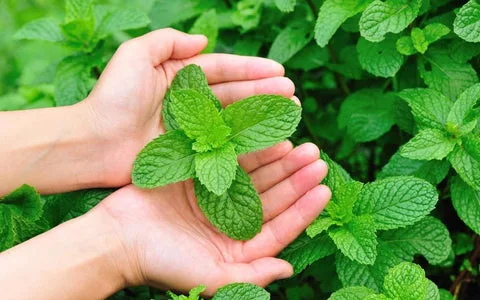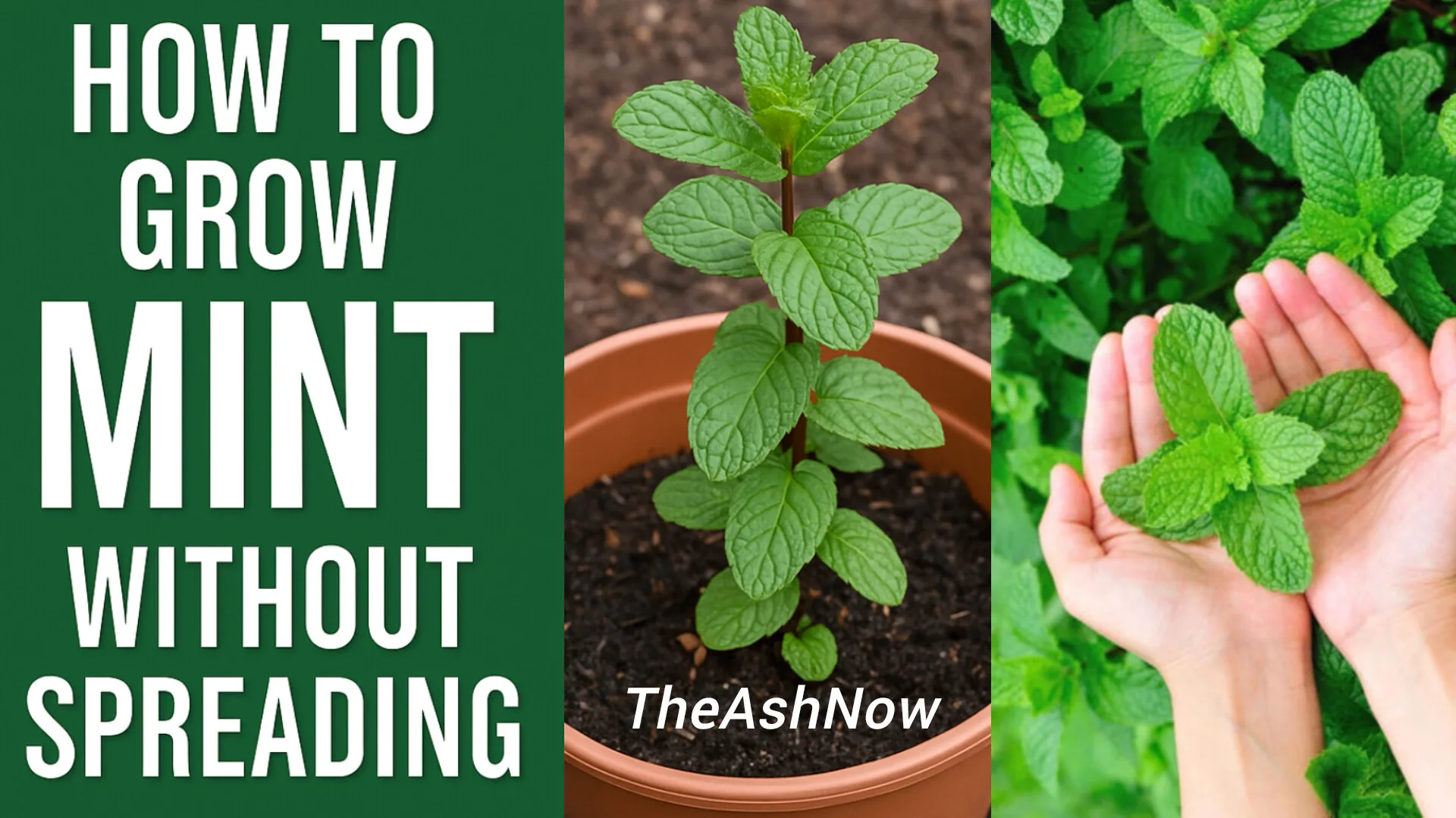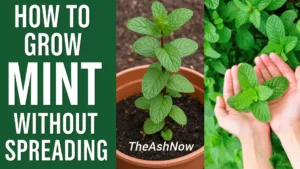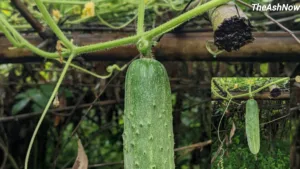Growing Mint Without Spreading: Your Ultimate Solution to Contain This Flavorful Garden Invader
Mint is one of the most beloved herbs worldwide, from mojitos to mint tea, and from salads to chutneys. But any gardener who’s grown it knows one thing for sure—mint spreads like wildfire if left unchecked.
At TheAshNow, we believe in enjoying your herbs without letting them conquer your garden beds. So here’s your complete, expert-backed guide on growing mint without it spreading, tailored for USA, UK, and other Tier 1 home gardeners.
Table of Contents
Why Does Mint Spread So Aggressively?
Mint (Mentha spp.) grows through rhizomes—underground stems that spread laterally and pop up in unexpected places. It’s nature’s little herb with big ambition.
“Give mint an inch, and it’ll take a yard.” – An old gardener’s proverb
The reason it’s so invasive?
- Rhizomatic root system: Grows horizontally underground
- Fast regeneration: A single broken root can form a new plant
- Ideal in temperate climates: Mint loves zones 3–11 (USDA)
So, how do we stop it from becoming a backyard tyrant?
Best Ways to Grow Mint Without Spreading
1. Grow Mint in Containers (The #1 Solution)
Container gardening is the gold standard for keeping mint in check. Whether it’s a small balcony or a large backyard, here’s how to do it:
Use These Container Tips:
- Size: At least 12–16 inches deep & wide
- Material: Terracotta, ceramic, or plastic—all work well
- Drainage: Must have holes at the bottom to avoid root rot
What to Grow It With:
Grow mint solo. Avoid pairing it with other herbs in containers—it’s too aggressive, even in pots.
🪟 Pro Tip: Place the pot on a concrete surface or raised stand to prevent rhizomes from sneaking into the ground.

2. Sink Bottomless Containers Into the Ground
If you’re going for that “herb garden aesthetic” but still want control, bury a pot or bucket in your garden with the bottom cut out.
This acts as a root barrier:
- Contain lateral rhizome spread
- Mint looks like it’s growing in the ground
- Easy to maintain
Depth tip: Sink the container 10–12 inches deep with 2 inches sticking above the soil to block runners.
3. Use Physical Root Barriers
Use commercial root barrier sheets made of plastic or metal to fence off mint from other plants.
Ideal for raised beds or permaculture zones.
- The barrier should go 18 inches deep
- Angle outward to prevent rhizomes from escaping below
- Overlap barriers to ensure zero gaps
4. Regular Root Pruning
If you’ve already planted mint in soil and can’t move it, prune the roots aggressively.
How to do it:
- Use a sharp spade to dig around the perimeter every few weeks
- Cut off any spreading runners
- Mulch heavily to suppress escapees
Frequency: Every 4–6 weeks during growing season (spring to early fall)
5. Use Underground Trays or Root Traps
Another smart solution is to plant mint inside a shallow tub or cement mixing tray buried in the soil.
This hack:
- Creates an underground mint jail
- Still looks like a normal herb patch
- Works great in small raised gardens
Pro Gardeners’ Real-Life Methods
🇺🇸 USA: Raised Bed + Concrete Borders
Karen from Oregon shared:
“I plant mint in a corner of my raised bed, surrounded by concrete pavers 18” deep. It hasn’t escaped in 3 years!”
🇬🇧 UK: Patio Pot Paradise
Robert from Brighton says:
“I grow three mint varieties in separate pots on my patio. Keeps the flavors pure and my garden clean.”
🇨🇦 Canada: Winter Cutbacks Help
Jessica in Ontario recommends:
“Each winter I trim it to soil level and dig around the perimeter. The freeze-thaw cycle helps limit spread.”

Bonus: Choose These Mint Varieties for Container Growing
Some mint varieties are better suited for pots due to their compact growth habit:
| Mint Type | Flavor Profile | Container Friendly? |
|---|---|---|
| Peppermint | Cool, intense | ✅ Excellent |
| Spearmint | Sweet, mild | ✅ Excellent |
| Chocolate Mint | Cocoa-mint scent | ✅ Very Good |
| Apple Mint | Fruity, fuzzy leaves | ⚠️ Grows larger |
| Pineapple Mint | Variegated, fruity | ✅ Decorative + Edible |
Final Tips from TheAshNow
- Water regularly – Mint loves moisture, but never soggy roots.
- Harvest often – Pinch off tips to prevent flowering and promote bushy growth.
- Keep in sun/partial shade – 4–6 hours of light daily works best.
- Repot yearly – In containers, refresh soil each spring to boost vigor.
Conclusion: Control the Spread, Love the Mint
Mint is a delightful herb that deserves a spot in your kitchen garden, but only with boundaries.
By following TheAshNow’s expert tips, you can:
- Keep mint from invading your garden beds
- Maintain beautiful, functional herb spaces
- Enjoy fresh mojitos, teas, and more—without guilt or garden chaos!
👉 Want more home gardening tips?
Frequently Asked Questions (FAQs)
1. Can mint be grown without spreading everywhere?
Yes. The best way to grow mint without spreading is in containers or pots with proper drainage. You can also use root barriers or bury bottomless containers in the ground.
2.Why does mint spread so fast in the garden?
Mint spreads rapidly due to its rhizome root system, which grows horizontally underground. These roots produce new shoots, making mint invasive if not contained.
3. What is the best container size for growing mint?
Use a container that is at least 12–16 inches wide and deep. This provides enough space for root development while keeping rhizomes confined.
4. Can I plant mint directly in the ground safely?
Yes, but only if you use a root barrier, such as a buried pot or plastic liner, to prevent the rhizomes from escaping and spreading across your garden.
5. Will mint overtake other herbs if planted together?
Yes. Mint is aggressive and will quickly choke out other herbs. It’s best to grow mint in separate containers to avoid competition.
6. How do you stop mint from spreading in the garden?
You can stop mint from spreading by:
Growing in containers
Installing root barriers
Regular root pruning
Using raised beds with solid edging
7. How often should I prune mint roots to control spread?
Prune mint roots every 4–6 weeks during the growing season by slicing around the root zone with a spade. This halts aggressive rhizome growth.
8. Can mint grow indoors without spreading?
Absolutely. Mint thrives in indoor pots near sunny windows. Indoor environments make it much easier to control the spread and monitor growth.
9. What’s the best mint variety for growing in pots?
Popular container-friendly mint varieties include:
Peppermint
Spearmint
Chocolate Mint
Pineapple Mint
These types remain manageable with regular care.
10. How do I repot mint without damaging it?
To report:
Gently remove the mint and trim excess roots.
Refresh with new potting mix.
Replant in a slightly larger pot.
Water thoroughly and place in a sunny spot.







